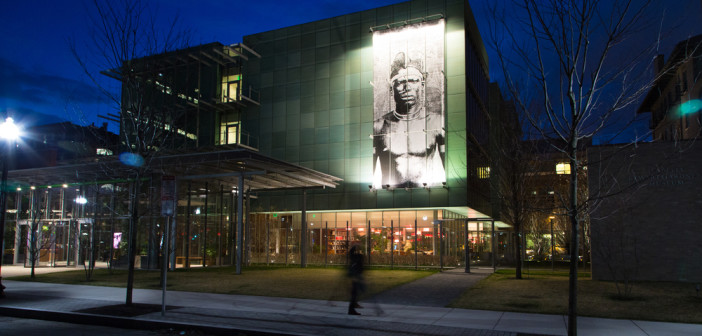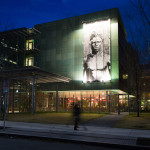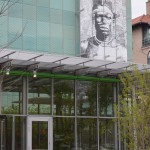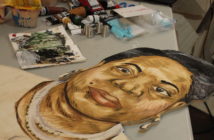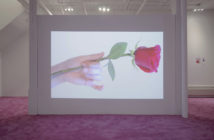Adrienne Edwards, Associate Curator of Performa in New York City, began her talk with Adam Pendleton at the Gardner Museum last Thursday night (May 2) by saying that their conversation would mimic the many long talks they have together as friends, often over dinner. "But it will be edited," Pendleton added.
However restrained, Pendleton and Edward's casual, fluid conversation illuminatingly considered the exigencies of Pendleton's multi-disciplinary conceptual practice. Perhaps best known for his humorous Black Dada paintings exhibited in the New Museum's first triennial, "The Generational: Younger than Jesus," (2009), Pendleton was a 2008 artist-in-residence at the Gardner. Last Thursday night, he described his period at the Gardner as pivotal for his career, which to date includes group and solo shows at the Tate Liverpool, The Kitchen and MoMA PS1, as well as the New Museum and Performa. Next year, Pendleton turns thirty, and the Contemporary Art Museum of St. Louis will present his first solo museum show. A few weeks ago, on their front façade of their recently built addition, the Gardner installed Pendleton's 36-foot-high Untitled (Fang Man from the Upper Ivindo Area, Northern Gabon, 1905-6/Furnishing Fabric, French or Italian, 1725-50). The installation juxtaposes a 1905 photographic portrait of a man, taken by a French officer, to an eighteenth-century silk damask with floral patterns, both from the Gardner's collection. It's is the second site-specific work to be commissioned for the Gardner's front and will be up for six months, through October. "They create a present tense," said Pendleton about the work during his talk with Edwards. "[It’s] a way of interrupting the Gardner’s history, [of]creating a new view."
Pendleton’s highly conceptual work is concerned with re-contextualization, hybridization and interruption. Edwards opened her conversation with Pendleton with a projected image of a table, covered in books and texts, that centers his studio. "The table is really a kind of collage," Pendleton said, as he described his process of identifying certain moments, elements, or instances to create new meanings. While Edwards understands this work as "assemblage," Pendleton identifies it as an "arrangement," as the elements in his work, be they textiles, speech, documents or texts, are carefully organized into altered or invented meanings. Touching on ideas by seminal conceptual theorists such as Lucy Lippard, John Cage and Sol Lewitt, Edwards asked Pendleton how he conceived of himself as a conceptual artist, and how that definition relates to the contemporary moment. "It's a bit about being irrational, an irrational mystic, if you will," said Pendleton. "[Conceptualism] means what that person defined it to be." Conceptual art is closely related to Realism, because it grounds and connects ideas within the physical world, he explained.
His comments on conceptual art as it relates to society, social activism and protest were the evening's highlights for me. Pendleton was born about an hour away from where I grew up in Virginia, and we're about the same age. Gender and race distinguish us, and I couldn't help but notice that the auditorium at the Gardner was mostly populated by women like me, or like my mother. But in discussing how he creates new meanings, and asks the viewer to expose their preconceptions and comprehensions in order to participate in those meanings, Pendleton expressed his art as transcendent and progressive, always evolving and operating within incompleteness. "I like this idea of incompleteness as an ethical position," he said. Edwards called his work "quietly politically motivated." Notes on Black Dada Nihilismus (Proper Nouns) (2009), consist of large black block letters affixed to a museum wall, reading out the names of pop-culture icons, African-American figures, artists and theorists. Its title referencing a 1970s controversial poem by Amiri Baraka, the work's meaning is entirely dependent on which names the viewer recognizes, and what their relationship to that public person is. Thus, the location of this installation shifts its meaning, but its simplicity and uniformity emphasizes universality. Difference and discord brought to the work through the viewer, it's not inherent. The list abruptly stops after the fifth row, incomplete, yet to be made whole.
Pendleton works with this idea again in his System of Display series (2008), first conceived of during his residency at the Gardner, which features black-and-white images and text silkscreened onto mirrored panels. Pendleton works from archival photographs and documents that have been photocopied and reproduced to homogenize their tone and feeling. A single, centered word is placed over each image, and letters are removed, leaving fragments of association and recognition.Pendleton's process heightens and emphasizes the distance between viewer and archive, while simultaneously neutralizing it by incorporating the viewer and thus allowing for a multi-faceted relationship between viewer, source and artwork. The experience of the past, present and future is collapsed and even completely invented, and yet rooted in Pendleton's subjective cropping and editing, which the viewer then subjectively experiences.
"Conceptual art doesn't have to lack feelings," Pendleton said at the talk's end. "It can be an emotive space." The Gardner, conceived and constructed in accordance to one person's taste and cultural context is conceptual, as Pendleton observed in his talk. His installation speaks to personal editing and archiving, and how those affect the public.
- Adam Pendleton, Untitled (Fang Man from the Upper Ivindo Area, Northern Gabon, 1905-6/Furnishing Fabric, French or Italian, 1725-50). Courtesy of the Gardner Museum.
- Adam Pendleton. Courtesy of the Gardner Museum.
- Outside the Gardner last Thursday night. Courtesy of Evan Smith.

